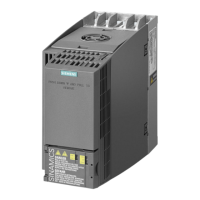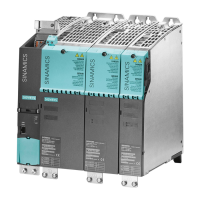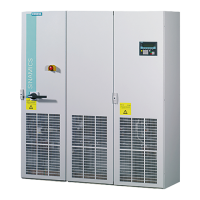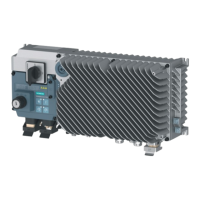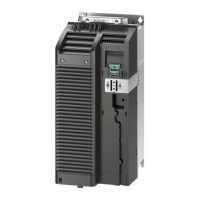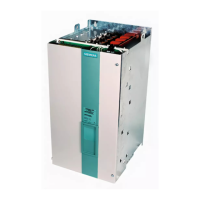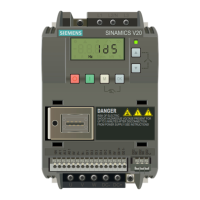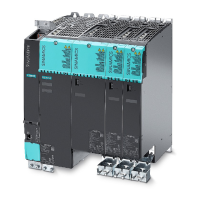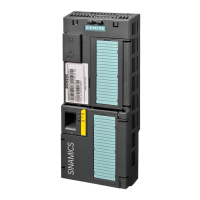Fundamental Principles and System Description
Engineering Information
SINAMICS Engineering Manual – November 2015
Ó Siemens AG
160/528
In the case of periodic load duty cycles with pronounced load current fluctuations (high short-time current and low
base load current), the temperature of the IGBT chips rises quickly during the overload period. The IGBT chips cool
down again very quickly during the subsequent period of base load current. As a consequence, the temperature
swings ΔT
Chip
are very pronounced, resulting in a small number of permissible temperature cycles. The permissible
number of temperature cycles can thus be reached relatively quickly in combination with short load cycle times, in
turn resulting in a relatively short IGBT lifetime. In order to prevent premature failure of the IGBTs due to periodic load
duty cycles which involve pronounced load current fluctuations, the appropriate current derating factor k
IGBT
defined in
section "Free load duty cycles" must be taken into account when load duty cycles are configured.
In operation with a low output frequency and a high output current, the output current flows during the positive half-
wave only through the IGBT connected to the positive bus of the DC link for a very long period as a result of the low
output frequency. As a result, the chips in this IGBT reach a very high temperature when the output current is high
while the temperature of the chips in the IGBT connected to the negative bus of the DC link drops quickly. During the
negative half-wave of the output current, the conditions are reversed. Under these operating conditions – even when
the rms value of the output current remains constant – the current load on the IGBT chips alternates with the output
frequency, resulting in very high absolute chip temperatures T
Chip
and extremely high temperature swings ΔT
Chip
. In
order to prevent instantaneous fault tripping as well as premature failure of the IGBTs in operation with a low output
frequency and high output current, the configuring guidelines outlined below must be observed.
Two criteria need to be satisfied to ensure correct operation of an IGBT module at low output frequencies, i.e. in
order to prevent immediate shutdown as a result of excessive chip temperature T
Chip
and to avoid premature failure
of the IGBT module as a result of excessive temperature swing ΔT
Chip
:
· The absolute chip temperature T
Chip
of the IGBT must never exceed the permissible limit value. This condition
must always be satisfied at every operating condition to protect the IGBT chip against instantaneous fatal
damage. The damage caused by excessive chip temperature is reliably prevented by the thermal monitoring
model implemented in SINAMICS converters which triggers an overload reaction when the permissible
temperature limit is reached. However, measures must be taken at the configuring stage to ensure that this
protective mechanism does not respond under the normal operating conditions for which the drive is
dimensioned.
· The temperature swing ΔT
Chip
of the IGBT must not exceed the permissible limit value at all, or only for a
tiny fraction of the total operating time. This condition must be fulfilled to avoid any significant reduction in
the lifetime of the IGBT. The temperature fluctuation is not continuously monitored by the thermal model.
Measures must therefore be taken at the configuring stage to ensure that the IGBT does not exceed the
permitted temperature fluctuation at all, or only for a small fraction of less than approximately 1 % to max.
2 % of the total operating time. Brief violations of the permissible limit, e.g. during rare starting or braking
operations, are therefore no problem provided that these operating conditions occur only for a small fraction
of less than about 1 % to max. 2 % of the total operating time.
1.12.3 Dimensioning of the power units for operation at low output frequencies
At high output frequencies, the chip temperature T
Chip
and the chip temperature swing ΔT
Chip
always remain within
permissible limits in both steady-state continuous operation and in all permissible load duty cycles specified in section
"Load duty cycles". As the output frequency decreases, the chip temperature and chip temperature fluctuation
increase continuously and can reach critical values below 10 Hz.
If no allowance is made for this relation when the drive is configured, there is a risk, depending on the operating
conditions, that the thermal monitoring model will intervene in an undesirable way and / or that the lifetime of the
IGBTs will be significantly reduced.
Measures which can be taken to prevent these problems are explained below.
1.12.3.1 Operation without overload at low output frequencies < 10 Hz
Depending on whether it is only necessary to prevent intervention by the thermal monitoring model in the event of
occasional low output frequencies, or whether the lifetime of the IGBTs also needs to be considered in cases where
low output frequencies occur frequently, i.e. corresponding to more than approximately 1 % to max. 2 % of the total
period of operation, the measures to be taken differ.
1.12.3.1.1 Operation without overload with occasional periods of low output frequencies < 10 Hz
In this case, the drive must only be configured to ensure that no overload reaction is initiated by the thermal
monitoring model. The effect on the lifetime of the IGBTs is negligible and need not be taken into account.
If the converter is to be operated occasionally, i.e. for a period corresponding to less than approximately 1 % to max.
2 % of its total operating period, at output frequencies of less than 10 Hz without intervention by the overload
reaction, the output current must be derated as a function of the output frequency according to the derating curve
below (precondition: Overload reaction setting is p290 = 1).

